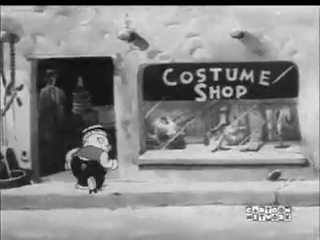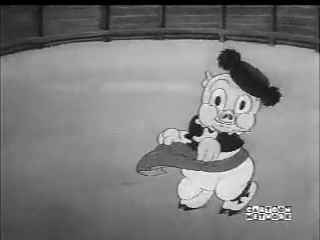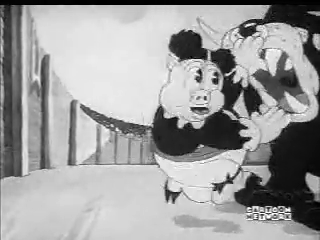DVD/BLU-RAY AVAILABILITY: Porky Pig 101 (WHV 5-DVD set)
Thanks to the official #1 pal of this blog, Devon Baxter, you can see a decent-enuf version of this cartoon HERE.
Apologies for the long delay in new postings. This is the only Avery-Warners cartoon that is really hard to see. Thanks to the modern day conglomo-monster that owns Warner Brothers, these black and white shorts have pretty much been chased off YouTube. Since they're actual cartoons, they're no longer shown on the Cartoon Network, save for rare relapses of taste and sanity by their programming directors.
With vintage cartoons on DVD pretty much dead in the mainstream, and the Blu-Ray format more inclined to serve up the latest slop from Hollywood, those early WB shorts that haven't been restored/reissued are not likely to be given such prestigious treatment in the foreseeable future.
End of screed. Let's get down to brass tacks...
The Fred Avery unit at Leon Schlesinger's cartoon studio has survived its first full year of movie-making. The unit has turned out anarchic, wildly inventive black-and-white cartoons, and a few less thrilling but auspicious Technicolor items. The look and feel of Avery's cartoons is now well-defined, with strong traces of the director's inimitable drawing style embedded in the work of his ambitious, talented animators.
The unit has not yet made a masterpiece, but one is close. In the meantime, Avery and Co. are once again content to attack movie genres. Hmmm; we just did a wrestling picture... how's about a bullfight? That's always funny.
Picador Porky was conceived with no greater ambitions than to evoke laughter from its late-Depression audience. That it takes greater steps towards the full-blown, baroque screwball humor that defines the Avery style, to so many animation fans, is frosting on the cake.
Avery loves to thwart expectations. If you know nothing else about his work, you know this. The rug is always ready to be yanked, hard, from 'neath the viewer's feet. Avery did this so well that, alas, the jokes of this type have long lost their impact. In 1937, some audience members were still falsely lulled by the soothing Tex-Mex strains that accompany this 20-second introduction:
We know this bubble exists just to be burst. And burst it Avery does, in a still-startling way. The center of the screen rips away, to reveal a scene of epic chaos, against the backdrop of the title card:
We breathe a sigh of relief; the next seven minutes and change will not be spent in vain.
The village of La Rosita is all-consumed in a Spike Jones-school rendition of "La Cucaracha," in which everyone and everything is part of the song. Gunfire accents the beat; a cross-eyed foursome's heads double as maracas; a toweling bather provides a guaro sound as he dries off; a bartender's cocktail shaker subs for castanets.
Into this comedic utopia strides Porky Pig, obviously on the bum...
and two nameless companions, who take in the pageant of chaos goggle eyed.
(crude panorama of said pageant)
The sign on the palm tree at far stage left catches the hobo trio's attention:
Pig and associates huddle to confer on this possible change in fortune:
No time is wasted in furthering their petty scheme.
The completely unnecessary "It's us!" tip-off, moments later, is another emergent Avery touch.
These two words, by the way, are the first narrative dialogue spoken, two minutes into the picture. As gabby as later 1930s cartoons often were, this restraint is a minor miracle, and it makes the dumbness of the line that much funnier.
A bullet-proof piece of stock sitcom is underway. What could possibly go wrong?
The estadio fills to capacity in a stock transitional scene that somehow merits a double exposure:
Porky and his nameless hobo pals sneak into the conveniently-labeled Bull Fighters Entrance, and meet the real bull, who is smitten with this pathetic counterfeit:
Real bull gets heave-ho; ninth-rate impostor takes place in cage. After some time-wasting antics with a fly, a strategically placed, labeled bottle of VINO catches the bum brigade's fancy:
(gagging, coughing) "Hey, this is fine stuff!"
The hind end of the partnership imbibes, and suffers the kind of rapid-fire freakout that we associate with the cartoons of Bob Clampett (hiccups courtesy of Mel Blanc):
(druggily:) "Oh, yah... whoa, yah."
The phoney bull hicks its way out of the bullpen...just in time for another Avery trope... the grand entrance, signified by a bejillion different doorways that open to mock-majestic fanfare...
...into which Porky proudly, stupidly saunters.
Avery's awareness of live-action cinema style gives these less essential moments a real polish. This tendency will continue through 1940, providing rare moments of visual relief during the deadly string of topical spot-gag pictures that will eventually make doing this blog seem more like washing dishes.
But that task is yet to come, and we're still having fun here...
The missing hobo-bull is discovered, and, as the comedy situation demands, the PO'd for-real bull is substituted...
Porky anticipates a smooth scam, but as the doorman raises the door-cum-drape of the bull entrance...
pig learns the awful truth!
Avery's go-to sight gag, early on, was to have a character spin like a top, with that signature sound effect that became a permanent part of the Warners cartoon arsenal. It's dispensed with clearly and painlessly immediately upon receipt of bull.There's been almost no dialogue, so far. Avery saves it for the essential moments, such as Porky's exasperated plea to the bull:
"Take it easy, b-b-b-boys! That was a l-little... close!"
We now witness the cartoon's first transcendental moment, in which solid personality animation brings to life the patently impossible:It's easy to imagine such a scene in a 1930 Van Beuren cartoon, a silent Felix the Cat, or even a Bill Nolan Oswald the Rabbit. This type of physics-wrecking gag, once a staple of the American animated cartoon, was frowned upon by West Coast animators, who were in sway to the restrictive (and patently false) realism of the Disney studio.
Avery can be seen as the savior of this utterly cartoony sensibility. His gift--the thing that makes this more than imitation--is his keen timing. This early on, Avery has it in spades. The uncanny sense to know when to shift from key pose to key pose is at the core of Avery's worth as a film-maker.
By the 1940s, Avery would be the master of this school of comedy. Further experience would give him the confidence to make these moves faster and sharper. Even in hindsight, this is a bravura moment--something film-makers weren't able to predict.
The bull is dazed in the wake of this time-space shift. Porky summons a caddy, and makes an utter mockery of the potentially-horrid climax of any successful bullfight... with plumber's helpers instead of spears. The matter-of-factness of this sequence is also something fresh for cartoons.
The bull gets some solo screen time, in which his animation eerily recalls the early work of Ub Iwerks, down to the Stan Laurel-esque gag that closes the sequence. Again, we see Avery channel the recent past of non-realistic cartoon animation:
Our soused gentlemen of the road sing and play a psychotic version of "La Cucaracha," full of killer Avery poses and dynamic, screen-violating animation.
This, ladies and gents, is what animation is all about--not multiplaned scenes of waterfalls, old mills and enchanted forests!
Distracted by this divine musical treat, Porky feels the cold bracing waves of reality slap him upside the head:
Porky and the Richard Burton-esque bull enjoy a moment of gratuitous fourth-wall rupture, as they run around the diameter of the Academy-ratio screen:
Just because they can...
The referee blows a mallet-cum-noisemaker, ending the first round. Porky
and bull freeze in place, but the pig (and his hat) proves harder to thaw out...
"Hallo, Ma? Hallo, Pa?"
The Iwerks style returns as the bull readies for his final assault......which Porky does not welcome with open arms.
Porky seeks refuge in the Safety Zone, which we know is patently un-safe, despite its according-to-code markers, signage, etc.
$@#!!&*!
Bull feigns indifference, nonchalance in another fine piece of personality animation--a touch that makes this throwaway moment funnier than it has a right to be.Personal space, in the Avery world, exists only to be violated, and its sanctity mocked.
And we revisit this oft-used chase cycle.
Drunky and Bummy come back into the picture, as they see their picador pal in peril... a past plot point is hastily revived!
Avery's poses of these two characters are redolent of his drawing style, and look forward to the eccentric character designs of his 1946-48 MGM cartoons.
Note strategically placed baseball bat and two-by-four.
(in unconvincing falsetto): "Moo-hoo!"
Bull, previously shown to have ardor for fake (presumably female) version of self, skids to halt, responds appropriately:The hobo boys, weapons at the ready, await the bull's love-smitten approach...
Avery sometimes writes out sound effects, in a holdover from silent animation. He would continue this trend, intermittently, in his MGM cartoons.
The real thing dispatched, the decoy moves into position for an easy win.
The judge gleefully hands over the pesos to Porky and companions.
Porky's alky pals notice the inevitable problem long before he does...
Porky runs in holy terror...
runs back to return the money, and heads for places unknown.
"Well! Eemahgin' that!"
And the curtain closes on the blurriest set of screenshots you'll ever suffer through here.Picador Porky, like its predecessor, makes hay with a routinely unappealing topic that, nonetheless, inspired a handful of great cartoons. The Fleischers' 1931 The Cow's Husband may be my favorite bullfighting cartoon, for its delightful music and its beyond-brilliant one way street routine. Their later Popeye entry, Bulldozing the Bull, is perhaps the most charming cartoon on this bloodthirsty sport. Other notable early bullfight cartoons include the Bill Nolan Oswald Rabbit slice-fest, Chilly Con Carmen (thanks to David Gerstein for reminding me about this one) and the surprisingly rowdy and enjoyable 1929 Disney Silly Symphony El Terrible Toreador.
Avery would return to bullfighting in his sublime, barrier-bursting 1949 gem Senor Droopy. (There's the bullfighting cartoon festival you didn't ask for!)
Avery and staff are still finding their way towards the light, but the increasing acuity and rapid pace of their gags and scenes continues to impress. Only Frank Tashlin, with his ultra-fast cutting and attention to detail, was making more cinematic cartoons than Avery in 1937.
The most significant moments in Picador Porky allow screwball humor to push everything else aside. Porky's nameless, boozer pals, though never to be seen again, give Avery the means to go completely wild for the first time in his stay at the Schlesinger studio. Their unpredictable rogue actions, and the blend of cliches from other sports pictures, distinguish a moderately good film.
This first flash of anarchy will be completely suppressed in Avery's next cartoon, but will return--with a bloody vengeance--immediately thereafter.
I will endeavor to make more regular postings on this blog in the new year. This will be a four-year haul, at the rate I'm going, but I hope you'll stay with me.
* -- be sure to read Mark Kausler's informative comments below. His insights are always a gift!
NEXT: Crooney tunes--I Only Have Eyes For You






































































































































































































































"It's easy to imagine such a scene in a 1930 Van Beuren cartoon, a silent Felix the Cat, or even a Bill Nolan Oswald the Rabbit."
ReplyDeleteThere is a Nolan Oswald bullfighting cartoon—CHILLY CON CARMEN. Look it up on YouTube... it's wilder than you'll ever believe.
Thanks for the reminder, David! I credited you in the body of the article for this welcome reminder.
ReplyDeleteThanks for the superlative post, Frank. The lengthy scene of the drunken bums is by Chuck Jones. Mel Blanc's favorite story of how he started at Schlesinger's as a "drunken bull", is really in reference to the voices he provided for the two bums. Mike Barrier states on page 338 of his HOLLYWOOD CARTOONS, that Tex was dissatisfied with Joe Dougherty's stuttering dialog, and that's why he had Porky speak less and less, as in "Picador Porky". When Mel Blanc took over Porky's voice, the character had much greater appeal.
ReplyDeleteThank you for your informative and kind comments, Mark. Your praise is significant to me. And thanks for that ID. I thought that was Jones' work, but I didn't want to hazard a guess...
ReplyDeleteAside from the looming changes in Porky's voice, this cartoon also foreshadows the change in Porky's design in the magician's cape bit -- the existing, more obese design, is replaced with a slimmer, 'cuter' version of the character that Avery would fully adopt in his next Looney Tune, and Clampett and Jones would then modify and improve over the next year.
ReplyDeleteHello from Belgium,
ReplyDeletelink is dead, I found these one :
https://www.dailymotion.com/video/x6pyb6l